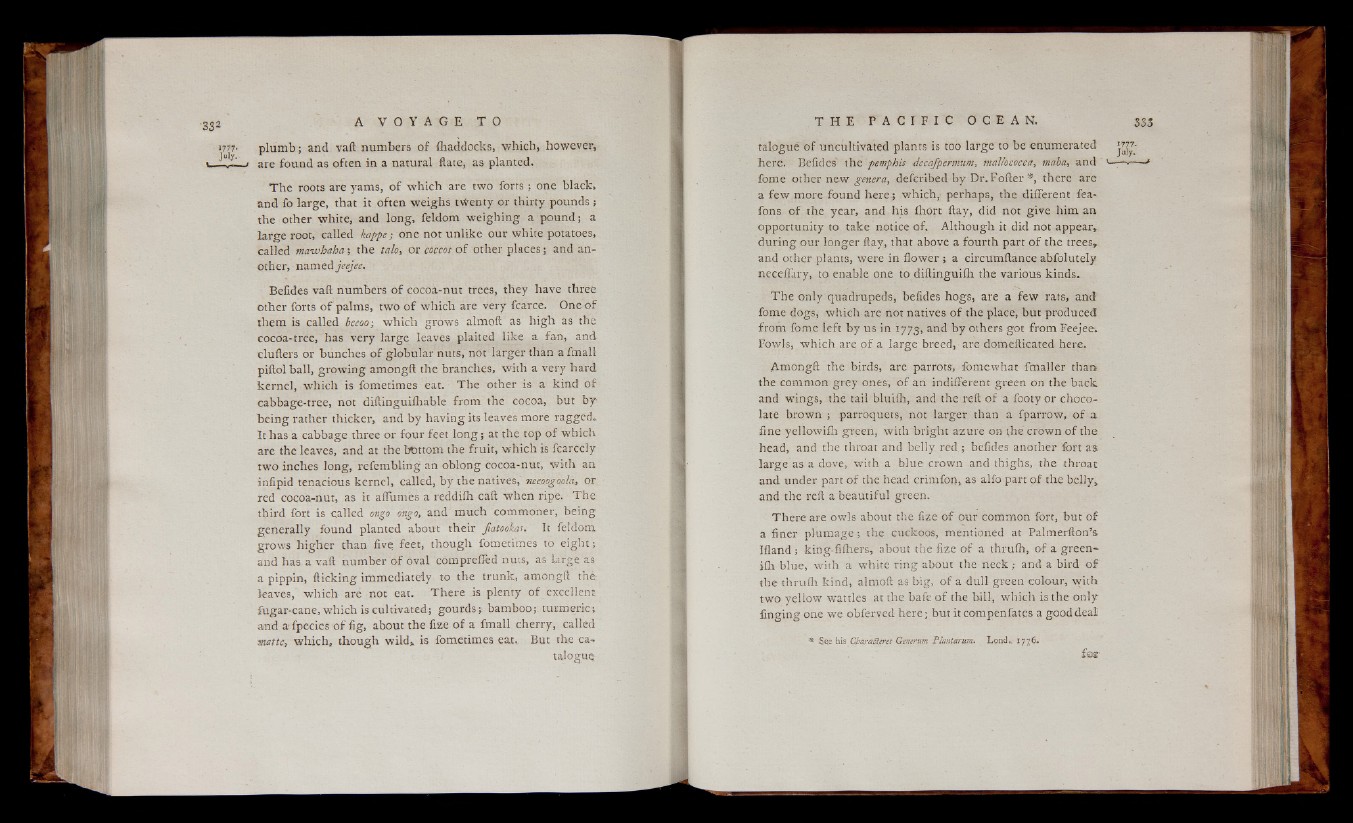
1777 ' July- plumb; and vaft numbers of fhaddocks, which, however,
are found as often in a natural flate, as planted.
The roots are yams, of which are two forts ; one black,
and fo large, that it often weighs twenty or thirty pounds ;
the other white, and long, feldom weighing a pound; a
large root, called kappe; one not unlike our white potatoes,
called maivhaha; the talo, or coccos of other places; and another,
n^LVntA jeejee.
Befides vaft numbers of cocoa-nut trees, they have three
other forts o f palms, two of which are very fcarce. One of
them is called beeoo; which grows almoft as high as the
cocoa-tree, has very large leaves plaited like a fan, and
clufters or bunches of globular nuts, not larger than a fmall
piftol ball, growing amongft the branches, with a very hard
kernel, which is fometimes eat. The other is a kind of
cabbage-tree, not diftinguifhable from the cocoa, but by
being rather thicker, and by having its leaves more ragged.
It has a cabbage three or four feet long; at the top of which
are the leaves, and at the bottom the fruit, which is fcarcely
two inches long, refembling an oblong cocoa-nut, with an
infipid tenacious kernel, called, by the natives, neeoogooh, or
red cocoa-nut, as it aftumes a reddifh caft when ripe. The
third fort is called ongo ongo, and much commoner, being
generally found planted about their fiatookat. It feldom
grows higher than five feet, though fometimes to eight;
and has a vaft number of oval comprefied nuts, as large as
a pippin, flicking immediately to the trunk, amongft the
leaves, which are not eat. There is plenty of excellent
fugar-cane, which is cultivated; gourds; bamboo; turmeric;
and a fpecies of fig, about the fize of a fmall cherry, called
matte, which, though wild, is fometimes eat. But the catalogue
talogue of uncultivated plants is too large to be enumerated J777-
here. Befides' the pemphis deccifpermum, mallococca, maba, and ' —
fome other new genera, defcribed by Dr. Fofter *, there are
a few more found here.; which, perhaps, the different fea-
fons of the year, and his fhort ftay, did not give him an
opportunity to take notice of. Although it did not appear,
during our longer ftay, that above a fourth part of the trees,
and other plants, were in flower ; a circumftance abfolutely
neceffary, to enable one to diftinguifh the various kinds.
The only quadrupeds, befides hogs, are a few rats, and
fome dogs, which are not natives of the place, but produced
from fome left by us in 1773, and by others got from Feejee.
Fowls, which are of a large breed, are domefticated here.
Amongft the birds, are parrots, fomewhat fmaller than
the common grey ones, of an indifferent green on the back
and wings, the tail bluifh, and the reft of a footy or chocolate
hrown ; parroquets, not larger than a fparrow, of a
fine yellowifh green, with bright azure on the crown of the
head, and the throat and belly red ; befides another fort as
large as a dove, with a blue crown and thighs, the throat
and under part of the head crimfon, as alfo part of the belly,
and the reft a beautiful green.
There are owls about the fize of Our common fort, but of
a finer plumage; the cuckoos, mentioned at Palmerfton’s
Ifland j king-fifhers, about the fize of a thrufh, of a green-
ifh blue, with a white ring about the neck; and a bird o f
the thrufh kind, almoft as big, of a dull green colour, with
two yellow wattles at the bafe of the bill, which is the only
finging one we obferved here; butitcompenfates a good deal
* See his Characi.eres G.enerum Plant arum. Lond,. 1776,
for